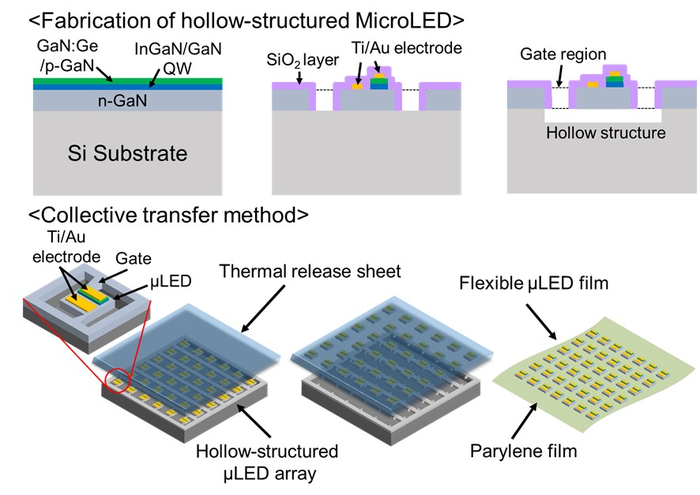Associate Professor Hiroto Sekiguchi of Toyohashi University of Technology’s Department of Electrical and Electronic Information Engineering, along with other collaborators developed a pliant and multipoint microLED array film.
 Technology to form a hollow structure of microLED (Upper) MicroLED array batch transfer technology (Lower). Image Credit: Toyohashi University of Technology.
Technology to form a hollow structure of microLED (Upper) MicroLED array batch transfer technology (Lower). Image Credit: Toyohashi University of Technology.
The researchers who collaborated on the project include Associate Professor Noriaki Ohkawa of Dokkyo Medical University’s Comprehensive Research Facilities for Advanced Medical Science and Assistant Professor Izumi Fukunaga of Okinawa Institute of Science and Technology Graduate University’s Sensory and Behavioral Neuroscience Unit.
It is possible to attach the film flexibly to cover the brain and can illuminate particular regions of it as microLEDs are organized along with multiple points of it.
Over the past few years, optogenetics has allowed the manipulation of neural activity by light. However, this method needs a light-emitting device, where there was no availability of any optical devices that could be fixed to cover entire tissues like the brain.
Also, this can be done with the light-impacting target neurons or can be implanted in an organism so that the activity would be manipulated freely with the help of light.
For this device to be implemented, there is a need for a thin, lightweight and pliant body. Hence, it was essential to set up a technology to arrange an LED layer that measures a thickness of a couple of micrometers that is highly accurate on an ultra-thin film that either does not cause any harm or is hazardous to the living tissue.
This time, the researchers fixed both: (1) a technology to develop a hollow structure of microLEDs with high density and in very fine detail, and (2) a high-accuracy batch transfer technology with the help of a thermal release sheet.
These technologies have played a significant role in successfully developing an ultra-thin, lightweight multipoint microLED array film that has the ability to retain lighting performance even in the bending position of the film.
The newly-developed device’s application has been anticipated to make a new area of neuroscience research. It has been aimed at extensively comprehending the brain data that supports how neural activity, behaviors and disorders are associated with each other
Details
Currently, researchers are trying to make use of light to handle the activity of numerous functional molecules present inside an organism. Specifically, optogenetics — a method to trigger neural activity with light by expressing photosensitive proteins that respond to a specific color of light present in neurons — has a high temporal resolution and has been used to explain brain function.
But to extensively clarify the complicated neural network made by neurons in the brain, it is essential to employ light stimulation that will allow free manipulation of a few regions of neurons distributed throughout an extensive range of the brain.
The application of traditional optical fibers and microscopes is not enough to illuminate some or multiple regions simultaneously and also limits the free movement of animals.
Even though this provided great hope for the application of an implantable LED device, the size of commercial LEDs is as high as 200 µm measuring the thickness of tens to one hundred micrometers, so it cannot cover a broad range of the brain. As such, it was considered inappropriate as a device to stimulate particular neurons in the regions.
The researchers have been making efforts to utilize a flexible film that is thin, bendable and weightless. Also, they took on the challenge of fabricating microscopic and ultra-thin microLEDs measuring below 100 µm and a couple of micrometers in thickness and fixing them on multiple points.
For this to be obtained, the anisotropic wet etching method using potassium hydroxide was adopted by the researchers to selectively eliminate the bottom LED layer. This resulted in the development of a hollow structure of microLEDs arranged at high density.
As the hollow structure isolates the LED layer from the substrate, only the LED layer could be removed at once by making use of a thermal release sheet causing no harm to either microLEDs or biocompatible Parylene films.
Employing this method has enabled the researchers to successfully fabricate a microLED array on the film.
This microLED-mounted film retains the lighting performance even in the bent position. Also, it has been confirmed that bright blue light could be obtained and utilized in real optogenetic experiments with the film that is attached to the surface of a mouse’s brain.
Future Outlook
Through this study, the multipoint microLED film was developed and it has possible broader application with the brain and will identify the control of complicated brain activity freely in the spatiotemporal views.
The brain consists of different functionalities in several regions and acts to control the whole body in a complicated approach. Through integrating the measuring technology in the future, the application of this technology has been anticipated to make a new area of neuroscience research targeted at extensively comprehending the brain information that supports the connection between neural activities, behaviors and disorders.
Moreover, with the advancement of photosensitive functional molecules within an organism, it is anticipated that it will be possible to illuminate light onto areas where medicine has been aimed and make the medicine quickly effective.
This will result in the application of phototherapy technology with the help of devices implanted in organisms.
The study was financially supported by the Precursory Research for Embryonic Science and Technology Agency (JPMJPR1885) of the Strategic Basic Research Programs in Japan Science and Technology Agency (JST), under the project title “Innovation of invasive LED devices for biological optical stimulation” in the research area “Development of optical control technologies and elucidation of biological mechanisms.”
Journal Reference:
Sekiguchi, H., et al. (2022) Adhesionable flexible GaN-based microLED array film to brain surface for in vivo optogenetic stimulation. Applied Physics Express. doi.org/10.35848/1882-0786/ac5ba3.